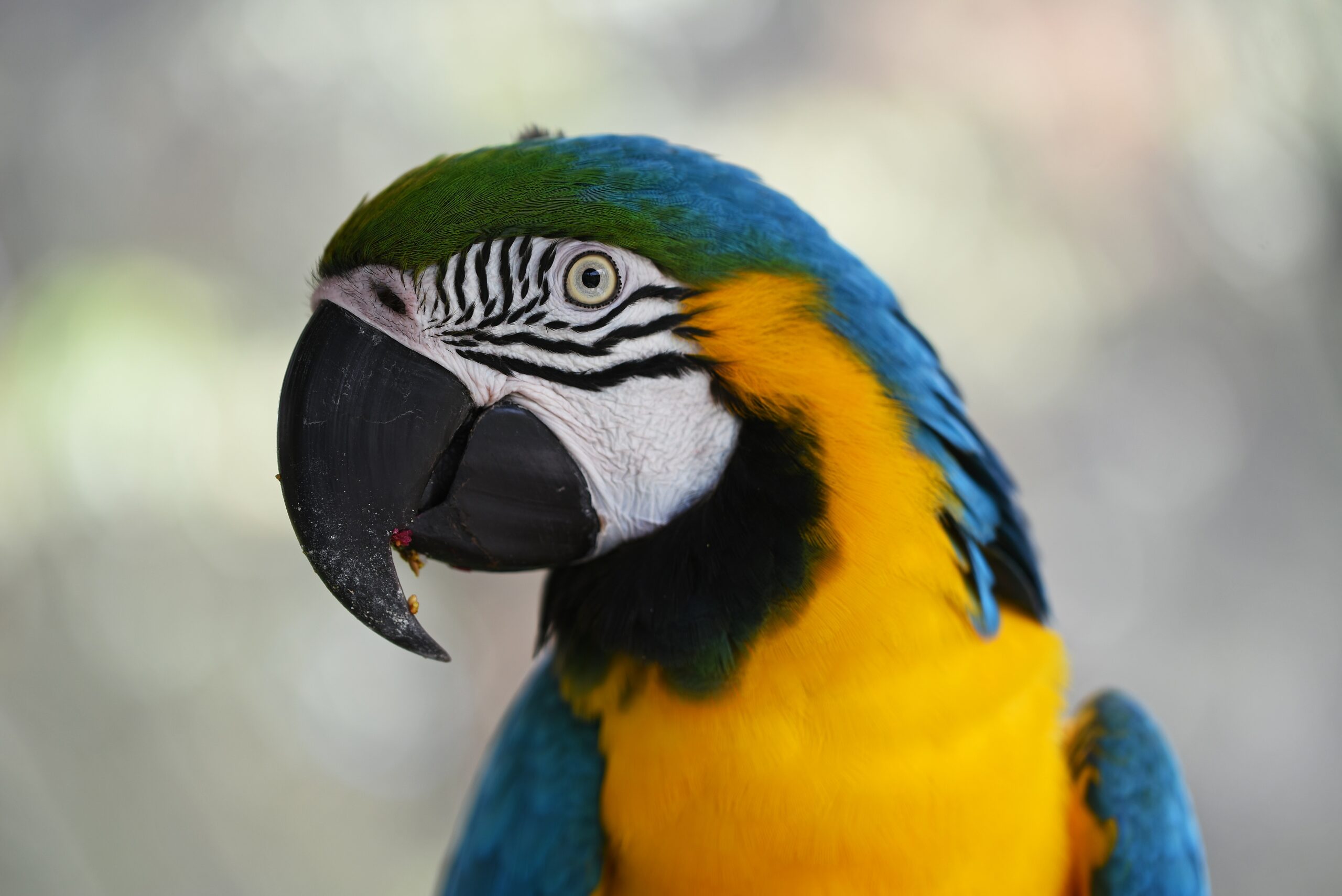Table of Contents
Build your Perfect Parrot Cage Setup
Making your parrot feel at home starts with a cozy and clean cage. Let’s break down the basics of setting up the perfect parrot pad.
Cage Liner and Cleaning Routine
Keeping the cage clean is essential for your parrot’s health. Swap out the cage liner regularly. Black-and-white newspaper works best since colored ink can be harmful to birds (North Hampton Vets). When changing the liner, make sure the waste hasn’t soaked through to the bottom layers.
| Cage Size | Cleaning Frequency |
|---|---|
| Small Cage | Monthly |
| Large Cage | Weekly |
For more details on cleaning schedules and techniques, check out our cage cleaning guide.
Food and Water Dish Maintenance
Keeping food and water dishes clean is super important. Wash them daily with hot soapy water away from where you prep your own meals. Rinse thoroughly to remove any soap residue and dry completely to avoid mold on food pellets (North Hampton Vets).
Many parrot parents use multiple sets of dishes, so there’s always a clean set ready while the other is being washed.
| Task | Frequency |
|---|---|
| Clean Food and Water Dishes | Daily |
For more tips on keeping your parrot’s diet in check, visit our page on parrot diet and nutrition.
By sticking to these tips, you can keep your parrot’s cage clean, comfy, and healthy. For more advice on encouraging natural behaviors and providing fun activities, check out our sections on providing stimulation and ensuring safety in the cage.
Cage Cleaning Guide
Keeping your parrot’s cage clean is crucial for their health and happiness. A tidy cage not only keeps diseases at bay but also makes for a cozy home for your feathered buddy. Let’s dive into the best ways to keep your parrot’s cage spick and span.
How Often Should You Clean?
How often you clean depends on the cage size. Big cages need a weekly scrub, while smaller ones can go a month between cleanings. A good rinse with a hose or in the shower, followed by a disinfectant, does the trick. Let the cage dry in the sun for that extra germ-killing power.
| Cage Size | Cleaning Frequency |
|---|---|
| Large | Weekly |
| Small | Monthly |
Source: North Hampton Vets
Here’s how to clean the cage:
- Move your parrot to a safe spot.
- Take out all toys, perches, and dishes.
- Rinse the cage with water.
- Scrub with a bird-safe disinfectant.
- Rinse off the disinfectant.
- Let the cage air dry in the sun.
Scrubbing Perches and Toys
Perches and toys can get pretty grimy. Use dish soap for a good clean. Bird poop on perches? Sandpaper works wonders. Some toys can go in the dishwasher, while rope toys can be tossed in the washing machine. Air drying is best, but you can also pop them in the oven at 250°F for 10 minutes.
| Item | Cleaning Method |
|---|---|
| Perches | Dish soap, sandpaper |
| Plastic Toys | Dishwasher |
| Rope Toys | Washing machine, oven (250°F for 10 mins) |
Source: North Hampton Vets
To keep things interesting for your parrot, rotate their toys and perches regularly. This keeps them entertained and fights off boredom. For more tips on keeping your parrot engaged, check out our section on providing stimulation for your parrot.
By sticking to these cleaning tips, you’ll create a clean and safe home for your parrot. Regular cleaning, along with proper care of food and water dishes and perch variety, will keep your feathered friend healthy and happy.
Keeping Your Parrot Happy and Active
Want a happy, healthy parrot? It’s all about creating an environment that keeps them busy and entertained. Here’s how you can make your feathered friend’s cage a fun place to be.
Keeping Them Busy
Parrots are smart and full of energy. They need both physical and mental activities to stay happy. Here’s how you can keep them engaged:
- Climbing Fun: Add ropes, ladders, and different types of perches. This not only keeps their muscles strong but also improves their coordination.
- Room to Fly: Make sure there’s enough space inside the cage for short flights. This helps them stay fit and mimics their natural behavior.
- Foraging Toys: Use toys that make your parrot work for its food. This keeps its brain active and simulates how it would find food in the wild.
- Interactive Toys: Toys with puzzles, mirrors, or bells can keep your parrot entertained and mentally sharp.
| Activity | Benefit |
|---|---|
| Climbing | Strong Muscles |
| Flying | Heart Health |
| Foraging | Brain Workout |
| Interactive Play | Mental Sharpness |
Want more tips? Check out our parrot care tips.
Encouraging Natural Behaviors
Helping your parrot act naturally is key to their well-being. Mimicking their natural environment can reduce stress and prevent issues like feather plucking. Here’s how:
- Natural Perches: Use branches of different sizes and materials. This keeps their feet healthy and prevents problems.
- Food Placement: Scatter food and treats around the cage to encourage movement and foraging.
- Nesting Materials: Give them safe materials to build nests. It’s a fun activity and keeps them busy.
- Bath Time: Offer a shallow water dish or mist them with water to encourage natural bathing behaviors.
| Natural Behavior | Method |
|---|---|
| Perching | Branches |
| Foraging | Scattered Food |
| Nesting | Safe Materials |
| Bathing | Shallow Dish or Misting |
Want to understand your parrot better? Check out our article on parrot body language.
Adding these activities to your parrot’s cage’ll create a fun and natural environment that keeps them happy and healthy. For more tips on training and engaging your parrot, visit our guide on how to train a parrot.
Keeping Your Parrot Safe in the Cage
Making sure your parrot’s cage is safe is super important. The way you set up toys, perches, and provide security and privacy can make a big difference in your bird’s happiness and health.
Toy and Perch Placement
When setting up toys and perches, think about your bird’s wingspan. They need room to flap and fly without getting hurt. According to BirdTricks, always check that everything in the cage is safe.
Handy Tips for Setting Up:
- Don’t overcrowd: Give your bird plenty of space to move around.
- Mix up heights: Place perches at different levels to encourage climbing and exercise.
- Secure everything: Make sure toys and perches are firmly attached to avoid accidents.
| Item | Where to Put It |
|---|---|
| Perches | Different heights, not directly above food and water dishes |
| Toys | Spread out so they don’t block movement |
Security and Privacy
Your parrot needs to feel safe and have some privacy. Birds are prey animals, so they need spots where they can hide and feel secure. This is key to setting up their cage (BirdTricks).
Tips for Security and Privacy:
- Create hiding spots: Use bird-safe materials to make little hideaways.
- Reduce stress: Put the cage in a quiet area away from lots of activity.
- Watch your bird: Adjust the cage setup based on how your bird behaves and what they like.
Think about where you put locks, food bowls, and perches. These can affect how your bird acts and interacts with their space. Knowing about behaviors like cage territorialism can help you make changes to keep your bird happy and stress-free (BirdTricks).
For more tips on making a safe and fun environment, check out our articles on parrot care tips and parrot behavior problems.
Why Perches Matter for Parrots
Perches aren’t just fancy bird furniture; they’re essential for your parrot’s health and happiness. They give your feathered buddy a place to chill and play, and they keep those little feet in tip-top shape. Let’s break down the types of perches and how to pick the best ones for your parrot’s pad.
Perch Types and Their Perks
Mixing up perch types is like giving your parrot a foot spa day, every day. Different sizes and textures help prevent foot problems and keep those toes nimble. Here’s a quick rundown:
| Perch Type | Why It’s Awesome |
|---|---|
| Varying Diameters | Stops arthritis and atrophy, boosts foot strength and agility |
| Natural Wood Branches | Feels like home in the wild, offers natural texture and fun |
| Rope and Natural Fiber | Cozy for older birds, soft on the feet |
| Sandy Perches | Keeps nails in check |
Picking the Perfect Perch Material
Choosing the right perch material is a big deal. Each type has its own set of pros and cons.
Natural Wood Branches: These are the gold standard. They mimic the wild with their varied textures and widths, making your parrot feel right at home. Plus, they keep those feet busy and healthy.
Wooden Dowels: Not the best choice. They’re too uniform and can be slippery. But if your parrot has toe issues, they might work temporarily.
Cement Perches: Steer clear. They can contain lead, which is toxic if chewed. Sandy perches are a safer bet for keeping nails trimmed.
Rope and Natural Fiber Perches: Great for comfort, especially for older birds. Just watch out for fraying, which can trap toes. Keep them trimmed to avoid accidents.
For more tips on making your parrot’s life awesome, check out our articles on parrot care tips and parrot behavior problems.
Cage Size and Setup Tips
Creating the perfect home for your parrot isn’t just about picking a cage; it’s about making sure every detail is right. Let’s break it down so your feathered buddy can live their best life.
Cage Size and Bar Spacing
Your parrot’s cage size is a big deal. A roomy cage means your bird has space to play and stay out of trouble. Cramped quarters can lead to bad habits like screaming for attention or plucking feathers.
Bar spacing is another thing to watch. Bars that are too wide or too narrow can be dangerous. Your parrot might get stuck or hurt. Here’s a quick cheat sheet on bar spacing for different birds:
| Parrot Species | Bar Spacing (mm) |
|---|---|
| African Greys, Caiques, Large Conures | 20-24 |
| Amazons, Eclectus | 20-24 |
| Small Macaws, Mini Macaws | 20-24 |
Want to know more about different parrot species? Check out our parrot species comparison page.
Where to Put the Cage and Out-of-Cage Time
Parrots are social butterflies. They need to be around people or other birds. Put the cage in a busy part of your home like the living room or even the kitchen (just make sure it’s Teflon-free). You can also roll the cage outside for some fresh air and sunshine.
Your parrot needs at least 3-4 hours outside the cage every day. Small birds like budgies and cockatiels can fly around the house, while bigger birds might enjoy a screened-in patio or garden aviary.
Here are some tips to keep your parrot happy:
- Social Interaction: Place the cage where there’s lots of action so your parrot feels included.
- Outdoor Time: Let your bird enjoy the outdoors in a safe, secure area.
- Exercise: Give your parrot space to fly and stretch its wings every day.
For more tips on parrot care, visit our parrot care tips page.
By paying attention to cage size, bar spacing, and giving your parrot plenty of out-of-cage time, you can create a fun and safe environment for your feathered friend. Happy bird, happy life!

